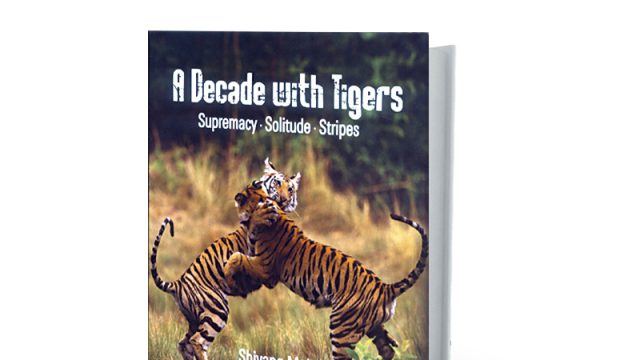When A Decade with Tigers was unveiled in October by a power-packed panel, including Mike Pandey, Valmik Thapar and Rajesh Bedi, the jury was split on the act of anthropomorphising tigers. While Shivang Mehta dodged the bullet then with diplomacy, his photobook owes its allure to the same trend. Divided into sections on tiger mothers and mighty males, further subdivided according to territory, the book tells scintillating stories of striped individuals who carved out a name for themselves in the tourism circuit with their frequent sightings. Journalist turned PR professional turned wildlife photographer, Shivang delves into his 14 years of experience with these characters, with candid anecdotes out of their lives. The writing is rather simplistic, but this book is mostly about its pictures.
Shivang is not a trigger-happy shutterbug; he chooses to wait for the perfect moment and strives for the right frame even when the subject is in plain view. It’s almost as if the stripes have rubbed off on him—he stalks the tiger much like the tiger stalks unsuspecting cheetal, waiting, lurking, and pouncing only when the time is right. This meticulousness shows in the book.
Having led hundreds of expeditions at the helm of Nature Wanderers, a nature tour operator, Shivang’s focus has understandably shifted to innovation. In the book, too, he declares that “the onus is on us… to constantly think of perspectives that bestow a new dimension to tiger imagery”. Some of his experiments do succeed, like high-key images that paint a greyscale tiger against a blinding white forest floor or the intentional shift of focus from tiger to kingfishers in the foreground, while others like the use of a tilt-shift lens look a tad jarring.
Corbett is Shivang’s favourite hunting ground, and this is where his genius shines. Declaring unflinching love for the Kumaon forests, he paints “the land of roar, trumpet and song” beautifully, taking poetic liberties with his frames. To him, the Himalayan tiger is a different subject altogether due to its habitat. Another standout section is the one without tigers. In ‘Denizens of the Tiger Kingdom’, he flaunts his vast repertoire—sloth bear cubs riding piggyback on their mother, a fishing cat against a starlit sky, otters in the Ramganga, etc.
Since two-third of the book is on famous tiger moms, the author has perhaps felt the pressure to cover all significant females. This has led to some below-par images making the cut , like in the case of T60 and her family, amid stunning pictures of mating, hunts and sibling behaviour. This raises a question pertinent to all wildlife photobooks—is the purpose exhaustive documentation or exquisite presentation?
The rare selection miss aside, the book is a great volume of creative tiger images and enrapturing tales—the kind that comes by once in a decade.




